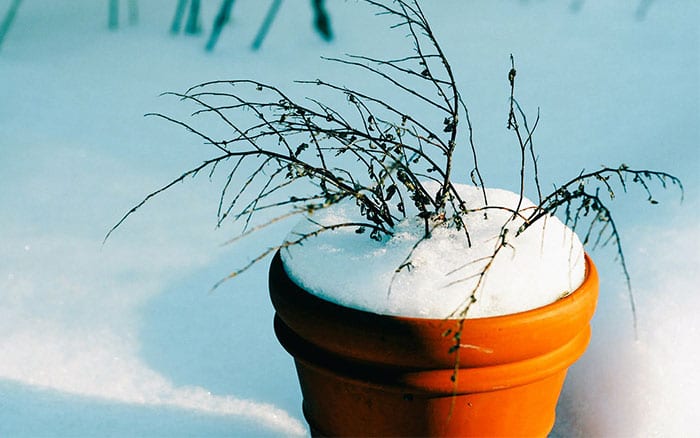Plants love to grow in pots during summer, but they are exposed to the elements in winter. In the soil, roots are protected by the warmth of the earth. But in pots they are vulnerable to winter frost, snow and cold winds.
Patio pots are also prone to waterlogging in times of heavy rain, which can kill plants. Sodden soil has all the air pushed out of it by the water, meaning roots can’t access any oxygen.
As if that’s not enough, cold temperatures can also cause pots to flake and crack, damaging or killing the plant in the process.
So, here is how to make sure all your container plants, and pots, survive the winter weather.
Move tender plants
Plants that are not winter hardy simply need moving to a frost-free location.
A cool greenhouse, porch or conservatory is ideal. Large, established specimens can be placed in a sheltered spot against the wall of the house, which should be warmer.

Crackin’ containers

Damaged pots in winter cost you twice – once to replace the pot and again to replace the plant.
There are two options for winter patio pots: frost-resistant, which is tough but may crack or flake in frost, and frost-proof, which should survive it. Generally, glazed ceramic pots survive the cold much better than unglazed terracotta.
But no pot will survive if the compost is waterlogged. Water expands when it freezes, meaning that wet compost will eventually crack the pot.
Even if you choose frost-proof containers, do not allow the compost to become waterlogged.
Protect pots from frost by moving them against the house, where the temperatures will be warmer. You can also wrap them in insulation or move them into an unheated greenhouse or shed when very cold temperatures are expected.
Winter waterlogging
Pot feet are brilliant inventions that lift pots up off the ground. This ensures that water can exit through the holes in the bottom and drain away.
You can buy special pot feet or use small bricks. I often use old wine corks too. Lift all your pots up in autumn as the weather starts to turn.

You can also move pots to more sheltered spots. Placing them against a wall or under the eaves of the house will protect them from the worst downpours.
Warm up

You can wrap pots up to help keep the compost and plant roots warm. A couple of layers of bubble wrap is a great insulator.
Or make ‘pot duvets’ from black plastic bags filled with straw or shredded paper. They look a bit odd but they will keep the soil warm.
Just make sure you don’t cover the compost surface with your insulation or your plants may rot. And make sure to remove any insulation when the weather warms up.

I like your idea of using old wine corks to lift the pots off the ground a bit and to also find a more sheltered area to move them to during storms. We have some unique flower pots that we absolutely love. We want to make sure they last a long time and that we take good care of them. They have been in my wife’s family for years and years. Thanks for the advice on how to make sure they stay in good shape!
thank you for the tips a great learning information medium for me
I am starting three new patio pots. I bought two inch washers and placed 3 of them under each pot. This allows water is drain from bottom hole and keeps pots balanced. Excited to see how these mini gardens grow!